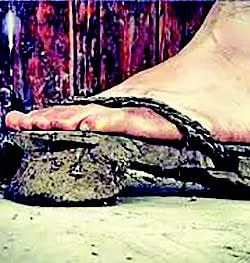Khraav is a type of traditional wooden footwear which was primarily used by people to protect their feet from snow. Due to poverty and unavailability of modern footwear, people in good old days, especially in rural areas, would wear this footwear to cope up with harsh winter season. T
hey called it Khorban in local parlance, which meant footwear. Unlike Pulhoer (traditional straw-woven footwear), Khraav is quite different and was particularly worn in snowy season.
However, in the present times, this traditional footwear is hardly seen anywhere, not even in the museums. The modern generation will be completely bewildered if they come across this customary footwear. But in the days gone by, it was the only winter shoes which people would afford to wear.
Then there were no markets. Life was decently simple. Material temptations were very least. The variety of shoes available in the markets today was simply unimaginable. People would prepare most of their daily use items either at home or in the vicinity.
For Khraav, they would give a carpenter (Tchaan in Kashmiri) short logs of wood to shape it out. The artisan (shoe-maker) would carve it out in just a day or two.
The wood of willow, mulberry or pecan would remain the preference for the durable and light Khraav among people. No sooner it would rain or snow in the villages those days than men would take this wooden footwear out to wear.
Initially, Khraav was mostly worn by the elderly men. And then the tradition of wearing it spread among the younger as well. Women too wore it. But, compared to Pulhoer, the craftsmanship to carve it out was difficult.
I recall, in winters people used to throng Nub Tchan’s, a famous carpenter in our locality, residence to make Khraav, also called Khravhur. Late Ghulam Nabi would shape the Khraav and take rice instead of money his charge. And the strips, they were done at home.
For straps people would either use grass-rope or leather-bands? As the time went by, this footwear was substituted by a variety of modern footwear that is available in the markets nowadays.
In my locality some elderly wore it even up to 2005. Small boys, in my village, were so fond of wearing Khraav that they would compel their parents to get them shaped out for them. But carpenters would refuse to shape out small ones as it would take them much time.
I vividly remember some elderly of my village were well-known for Khraav wearing. Though they all have passed away now yet, I am sure if we try to search it out today in their houses, we will find it there. In my neighborhood, couple of years before, Fahim Kak (name changed ) would wear it quite often during rainy days. It would fascinate us so much when we would see him wearing it. We would even request our parents to get the same carved for us as well.
It is pertinent to differentiate here between Khraav and Pulhoer. Khraav was the footwear to be worn within the village. For going around in the vicinity or for longer distances, another traditional footwear was also in vogue and it was Pulhoer (straw footwear).
Pulhoer unlike Khraav didn’t need any carpenter to prepare out. It was made at home. Unlike Khravhur, Pulhoer was light. People would wear it only in the dry weather or when it would snow very heavily.
During snowfall, people would fill inside the grass-made Pulhor some cloth pieces in order to save their feel from getting cold. Pulhoer would tear or tatter after two years but Khraav would remain intact for many years.
Culture & Heritage Preservationist, Kashmiri Poet and Social Activist Zareef Ahmad Zareef about this traditional footwear said that Khraav was an important part of our tradition once, we have lost to so called modernity over the years.
“It was worn by people, both in urban and rural areas; however, more in urban areas where money instead of grains was given to artisans for making it. I wore it as well and it still exists in maximum homes in Kashmir. Until yesteryears, I, out of love for culture, would visit Mtr. Late Atiqa Bano’s (a renowned educationist of Kashmir) Meeras Mahal Museum at Sopore where Khraav is still available. Those who want to revive their cultural and traditional memories should visit this ethnographic museum in Sopore and gain knowledge about the rich past of Kashmir. In Meeras Mahal Museum most of the artefacts are daily use items of Kashmir that were a common sight until the end of 20th Century,” he added.
Majority among us today, are far from their culture and tradition. They wonder about the bye gone era when it was a custom to wear Khraav. They raise eyebrows when they come across some conventional item in books or on social media.
In fact, there are plethora of traditional item which we must educate our new generations about. Experts who frame the syllabi for these students must introduce such lessons in the curriculum that are related to culture and heritage.
Otherwise time will soon come when this future generation will vehemently deny recognizing traditional stuff. After all, it is shocking if one has vast knowledge about foreign culture but knows very little about his own.
Manzoor Akash is teacher English, Dept. of School Education J&K
DISCLAIMER: The views and opinions expressed in this article are the personal opinions of the author.
The facts, analysis, assumptions and perspective appearing in the article do not reflect the views of GK.







